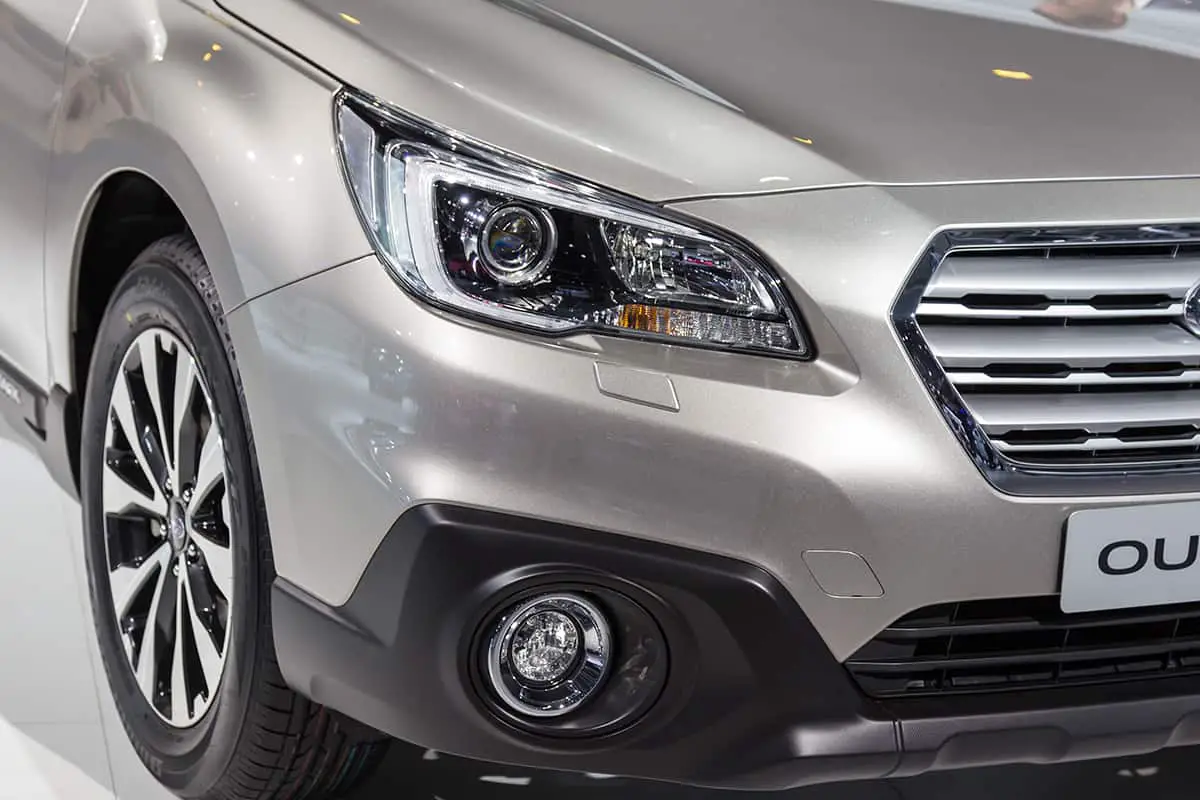The Subaru Outback is a crossover SUV with standard all-wheel drive and a spacious interior. It has a reputation for being reliable, rugged, and capable of handling various types of terrain. While it’s an excellent crossover, it’s not the only one.
Here are 10 of the most noteworthy alternatives to the Subaru Outback:
- Chevrolet Traverse
- Hyundai Palisade
- Hyundai Tucson
- Jeep Grand Cherokee
- Kia Soul
- Mazda CX-5
- Nissan Rogue
- Toyota 4Runner
- Volvo V60 Cross Country
- Volkswagen Golf SportWagen
Now, let’s see what each of these crossover SUVs offers and how they compare to the Subaru Outback.
1. Chevrolet Traverse

Every single Traverse has a 3.6-liter V-6 engine producing 310 horsepower and 266 pound-feet of torque. Those figures stack up favorably against competing vehicles like the Honda Pilot and Subaru Ascent. All trims can be had with either FWD or AWD and a nine-speed automatic transmission.
All trims have automatic emergency braking, lane-keeping assist, and high-beam control. In higher trim levels, blind-spot monitors come standard, but the base LS has the upgradable option. Adaptive cruise control, a 360-degree camera, and a more sophisticated AEB system are all standard on the higher trim levels.
The LS and LT Cloth trims have a 7-inch infotainment touchscreen. The display and navigation system are upgraded to a larger 8.0 inches in the RS and higher trim levels. Both support Apple CarPlay and Android Auto wirelessly and have USB ports in all three rows. Except for the most basic model, wireless charging is standard. A digital instrument cluster measuring 8 inches in diameter is standard on Premier and High Country trim levels.
2. Hyundai Palisade
The Palisade has a 3.8-liter V-6 engine and an eight-speed automatic transmission. The 291 hp offered by the engine is more than enough for this type of vehicle. Paddles on the steering wheel allow you to manually shift the Palisade’s transmission.
Only the Limited and Calligraphy trims seat seven people due to the presence of the captain’s chairs in the middle row. In any case, all three rows can comfortably accommodate their passengers. To get to the third row, press a button on the second-row seat to slide forward.
Standard on all trims is a 12-inch touchscreen infotainment system with Android Auto, Apple CarPlay, in-dash navigation, SiriusXM satellite radio, and Bluetooth connectivity. The system supports up to seven USB devices and dual Bluetooth connections. The Palisade can be remotely locked, unlocked, and started when Hyundai’s Blue Link app service is installed.
3. Hyundai Tucson

The base trim level will include a 2.5-liter four-cylinder engine producing 187 horsepower, mated to an eight-speed automatic transmission, and available with either front-wheel or all-wheel drive. Hybrid and plug-in hybrid models will be powered by a turbocharged 1.6-liter four-cylinder.
The Tucson’s cabin is uncluttered but up-to-date thanks to its digital gauge display, push-button shifter, and touch-sensitive control panel for the A/C and stereo.
Apple CarPlay and Android Auto are standard on the 8.8-inch touchscreen built into the dashboard, while a 10.3-inch screen with integrated navigation is available as an upgrade. Hyundai also offers a digital key app for smartphones to lock and unlock the vehicle and even start it remotely.
4. Jeep Grand Cherokee
The new Grand Cherokee is offered with the same 293-horsepower, 3.6-liter V-6 and 357-horsepower, 5.7-liter Hemi V-8 as the outgoing model. Jeep also provides its plug-in hybrid 4xe powertrain, which combines a turbocharged 2.0-liter inline four and an electric traction motor to produce 375 hp and 470 lb-ft of torque.
A completely redesigned replacement has replaced the outgoing Grand Cherokee’s somewhat dated cabin. While the Laredo trim level provides the basics, the Summit and Overland add luxurious touches like quilted leather upholstery, open-pore wood trim, and cutting-edge digital displays. The standard Grand Cherokee SUV only seats two, but the longer Grand Cherokee L can accommodate up to seven passengers.
The Grand Cherokee has a standard 8.4- or 10.1-inch touchscreen with Apple CarPlay, Android Auto, and SiriusXM satellite radio that floats just above the dashboard. Higher-end models can be equipped with a digital gauge cluster, a 10.0-inch head-up display, and another 10.3-inch display embedded in the dashboard for use by the front-seat passenger, in addition to standard features like in-dash navigation with real-time traffic and weather updates.
5. Kia Soul

The only available drivetrain consists of a 2.0-liter four-cylinder producing 147 horsepower and is mated to a CVT and front-wheel drive. It could reach 60 mph in just 8 seconds.
Because of its upright design, the Soul’s cabin has plenty of room for passengers and their belongings. To complement the Soul’s stylish exterior, Kia’s designers gave the interior a dose of youthful cheekiness with textured door-panel inserts and bright trim.
All but the base model receives a large 10.3-inch touchscreen for the infotainment system; the LX gets a smaller 8.0-inch unit. Apple CarPlay and Android Auto compatibility are standard across the board. If you go for a version with a 10.3-inch screen, you’ll also get features like SiriusXM satellite radio, live traffic updates, built-in navigation, and a wireless charging pad for your smartphone.
6. Mazda CX-5
The CX-5’s standard four-cylinder engine produces 187 horsepower, but its quick response to the accelerator makes it feel much more powerful. Its lack of power becomes apparent at higher speeds when you’re making a pass or merging onto the freeway.
Thanks to the high-quality materials and thoughtful design, it has a high-class vibe. A floor-hinged accelerator pedal provides a more natural feel than the standard, suspended-above-the-floor design; the expertly crafted steering wheel is positioned squarely in front of the driver rather than at an angle; and the armrests in the front seats are all the same height.
Every version comes standard with a 10.3-inch infotainment screen controlled primarily by a rotary controller and volume knob in the center stack. Voice commands and steering wheel buttons are additional interface inputs. Both Apple CarPlay and Android Auto come pre-installed on all models. Mazda Connected Services, included with every CX-5, grant the driver access to the car’s features from afar with the help of a smartphone app and a paid Wi-Fi hotspot.
7. Nissan Rogue

Every single 2023 Rogue has a 1.5-liter turbo-three generating 201 horsepower. The inline-three is paired with a CVT and front-wheel drive; all-wheel drive is available as an upgrade.
Several high-quality design elements, such as cubby holes for stowing items, a split-level dashboard, and a square shift knob, contribute to the vehicle’s overall pleasant appearance and practicality. While the cloth is standard, faux leather is available for the SV and comes standard in the SL and Platinum Rogues.
A touchscreen infotainment system is prominently displayed on the dashboard. The base Rogue comes with an 8.0-inch display, while the SL and Platinum trims offer a larger 9.0-inch screen as an option. Premium features like in-dash navigation and a Bose stereo system are available, and high-end features like Apple CarPlay and Android Auto come standard. In addition to a massive 10.8-inch head-up display and a wireless smartphone charging pad, the Platinum model’s 12.3-inch reconfigurable digital gauge cluster is a standout feature.
8. Toyota 4Runner
The 270 hp V-6 engine in every 4Runner is mated to a five-speed automatic transmission. Full-time or part-time four-wheel drive systems and standard rear-wheel drive systems are both available.
The 4Runner’s cabin is dated in comparison to more modern vehicles. The 4Runner is more than just a rock-crawler; its adaptable cargo area and numerous large, deep cubbies in the front row make it a capable hauler.
An eight-inch touchscreen infotainment system is standard in every 4Runner. Physical buttons and rotary volume and tuning knobs make up the interface. Apple CarPlay, Android Auto, and a Wi-Fi hotspot that requires a monthly fee are all included in the system’s base price. You can get a fancy JBL sound system with 15 speakers and a built-in navigation system if you want to.
9. Volvo V60 Cross Country
The Cross Country has an all-wheel-drive system and a 250-horsepower turbocharged four-cylinder engine. The V60 Cross Country’s handling is agile and responsive so long as you don’t overtax it.
The V60 has a wonderful interior, as is typical of Volvo vehicles. There’s plenty of room inside, the seats are supportive, and the interior looks and feels high-end. However, the infotainment system in a Volvo has many controls buried deep within its minimalist interface.
Volvo’s Android-based infotainment system is standard on the V60 and V60 Cross Country. The new interface is just as fast and fluid as the previous Sensus Connect system, but it runs on the same vertically oriented 9-inch touchscreen.
10. Volkswagen Golf SportWagen
The 147-horsepower 1.4-liter turbocharged four-cylinder engine in the Golf SportWagen with front-wheel drive. When upgrading to all-wheel drive from the standard rear-wheel drive on the base S model, you get a more potent 170-horsepower 1.8-liter turbocharged four-cylinder.
There is little difference between the SportWagen and the regular Golf regarding the cabin’s dimensions. The SportWagen has enough head- and legroom for four six-footers.
The SportWagen has a wide variety of safety features and performs well in crash tests. Autonomous emergency braking, forward collision warning, pedestrian detection, and blind spot monitoring are all available as part of the Driver Assistance package.






